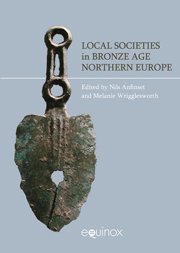Book contents
- Frontmatter
- Contents
- List of figures and tables
- Contributors
- Acknowledgements
- Introduction: local societies, regions and processes of cultural interaction in the Bronze Age
- PART I IDENTITY, GRAND NARRATIVES AND NETWORKS
- 1 Approaching a complex past: entangled collective identities
- 2 Asymmetric twins? Some reflections on coastal and inland societies in the Bothnian area during the Epineolithic and Early Metal Age
- 3 Expressing identity through ritual in the Early Bronze Age
- 4 Large-scale “grand narratives” and small-scale local studies in the Bronze Age discourse: the animal perspective
- 5 Reconsidering a periphery: scenarios of copper production in southern Norway
- 6 On the bronze trail: short-cuts, byways, transformation and displacement
- PART II REGIONS, GLOBALIZATION AND RESISTANCE
- Index
5 - Reconsidering a periphery: scenarios of copper production in southern Norway
from PART I - IDENTITY, GRAND NARRATIVES AND NETWORKS
- Frontmatter
- Contents
- List of figures and tables
- Contributors
- Acknowledgements
- Introduction: local societies, regions and processes of cultural interaction in the Bronze Age
- PART I IDENTITY, GRAND NARRATIVES AND NETWORKS
- 1 Approaching a complex past: entangled collective identities
- 2 Asymmetric twins? Some reflections on coastal and inland societies in the Bothnian area during the Epineolithic and Early Metal Age
- 3 Expressing identity through ritual in the Early Bronze Age
- 4 Large-scale “grand narratives” and small-scale local studies in the Bronze Age discourse: the animal perspective
- 5 Reconsidering a periphery: scenarios of copper production in southern Norway
- 6 On the bronze trail: short-cuts, byways, transformation and displacement
- PART II REGIONS, GLOBALIZATION AND RESISTANCE
- Index
Summary
Introduction
From a Norwegian point of view, the academic division of the Bronze Age world into centres and peripheries has been an obstacle to understanding the impact made by metals and metallurgy in this remote corner of the world. The scarcity of bronze finds has been the point of departure for most Bronze Age researchers, whether arguing that the Norwegian Bronze Age culture was qualitatively different from that of central Scandinavia, or that it was rather a matter of degree than of cultural level. Despite the fact that Norway has rich and easily available copper deposits, the utilization of local copper has been considered implausible, mainly judging from the presumption that the copper-bearing regions lacked the technological and organizational premises for any such production. Over the last few years, however, the general attitude towards this topic has changed; several scholars now advocate some level of indigenous production on the Scandinavian Peninsula. A number of questions regarding regionality and, more specifically, relations between centres and peripheries, arise in the wake of this turn. The first question is rhetorical, but nevertheless essential: if groups at the outskirts of the Bronze Age world had direct access to metal, does this by definition make them less peripheral? Another question relates to source-critical factors: why are there so few signs of conspicuous consumption (i.e. social competition) expressed through largescale depositions of metals in the areas with high potential for prehistoric mining?
- Type
- Chapter
- Information
- Local Societies in Bronze Age Northern Europe , pp. 89 - 107Publisher: Acumen PublishingPrint publication year: 2012

